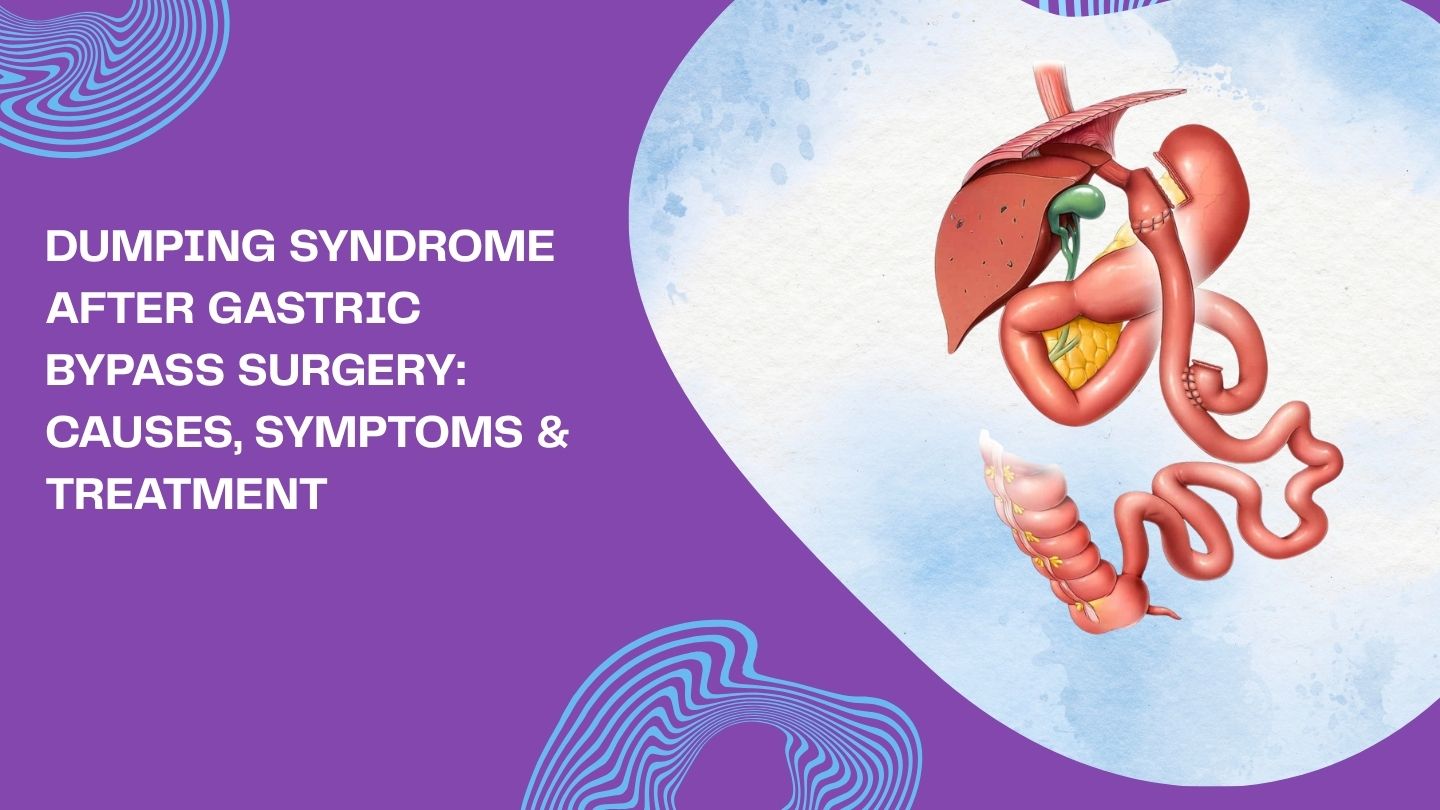
Dumping Syndrome After Gastric Bypass Surgery: Causes, Symptoms & Treatment
After gastric bypass surgery, some patients experience uncomfortable digestive symptoms triggered by rapid food movement from the stomach into the small intestine. This condition can lead to nausea, cramping, and lightheadedness shortly after eating. Understanding its causes and management is key to maintaining long-term digestive health and comfort. With the right dietary and medical strategies, these symptoms can be effectively controlled. In this blog, we’ll explore the causes, symptoms, and treatment options for this post-surgical condition.
Key Takeaways
- Dumping syndrome, a common complication after gastric bypass surgery, is categorized into early and late types, each with distinct symptoms and timing related to rapid gastric emptying.
- Dietary changes are the primary approach to managing dumping syndrome, with recommendations to avoid high-sugar foods, incorporate more protein, and consume smaller, more frequent meals.
- If dietary modifications do not alleviate symptoms, medications and, in rare cases, surgical interventions may be necessary for effective treatment and long-term management.
Understanding Dumping Syndrome
Dumping syndrome describes the effects of food rapidly emptying into the small bowel, disrupting normal digestion. This condition often occurs in patients following gastric bypass surgery due to changes in how the stomach empties, resulting in the small intestine receiving large amounts of undigested food. The syndrome can be categorized into two main types: early and late dumping syndrome.
Uncontrolled gastric emptying in dumping syndrome is caused by impaired coordination of muscles, nerves, and hormone signals. Early dumping syndrome occurs 10-30 minutes post-meal, while late dumping syndrome occurs 1-3 hours after eating. Recognizing these differences aids in the effective management and diagnosis of the condition called rapid gastric emptying.
Types of Dumping Syndrome
Dumping syndrome is categorized into early and late types, each with unique symptoms and timing. Early dumping syndrome appears soon after meals, whereas late dumping syndrome occurs a few hours post-eating.
These two types, though resulting from the same underlying issue of rapid gastric emptying, affect the body differently. Early dumping syndrome often leads to immediate gastrointestinal distress, while late dumping syndrome primarily impacts blood sugar levels.
Exploring these types in detail can help in understanding their distinct characteristics.
Early Dumping Syndrome
Early dumping syndrome is caused by a dense mass of food dumped too early into the small intestine, occurring 10 to 30 minutes after eating. This rapid emptying triggers symptoms such as:
- Nausea
- Abdominal discomfort
- Sweating
- Heart palpitations
- A feeling of fullness after eating only a little
High-sugar foods and sugary drinks are particularly problematic, often exacerbating these symptoms related to sugar content.
Meals heavy in starches or sugars are common triggers for early dumping syndrome. These foods can lead to severe symptoms, including abdominal cramps and reactive hypoglycemia in more extreme cases. Managing early dumping syndrome heavily relies on avoiding these triggers.
Late Dumping Syndrome
Late dumping syndrome occurs 1 to 3 hours after eating and is characterized by a rapid drop in blood sugar levels. This condition often leads to symptoms like faintness, shakiness, and heart palpitations as the body reacts to the sudden change in blood sugar. Foods and drinks high in sugar can exacerbate these late dumping symptoms.
The symptoms of late dumping syndrome are triggered by blood sugar changes due to insulin release. Effective management of late dumping syndrome involves recognizing its symptoms and understanding their triggers.
Causes of Dumping Syndrome Post-Gastric Bypass
The surgical alteration of the stomach during gastric bypass surgery significantly impacts its ability to regulate food passage. This change can cause the stomach to empty too quickly into the small intestine, leading to dumping syndrome. The prevalence of dumping syndrome among post-bypass surgery patients can reach 50%, particularly affecting females. Stomach surgery can have lasting effects on these patients.
Rapid emptying of food into the small intestine is a key factor leading to dumping syndrome. Additionally, an imbalance in gut hormones following gastric surgery can contribute to this condition. Identifying these causes is key to developing effective management and treatment strategies.
Symptoms of Dumping Syndrome

Dumping syndrome can lead to symptoms such as nausea, vomiting, and diarrhea soon after eating. Initial symptoms of early dumping syndrome include nausea, bloating, and abdominal cramps, often triggered by rapid gastric emptying. Dumping syndrome can occur, and these symptoms can be severe and disruptive to daily life.
Late dumping syndrome symptoms include faintness, shakiness, and heart palpitations due to drops in blood sugar. Both types can cause overlapping symptoms like nausea, bloating, abdominal cramps, and heart palpitations, including mild symptoms. Identifying these symptoms is the first step towards appropriate treatment.
Diagnosing Dumping Syndrome
Diagnosing dumping syndrome often begins with identifying patient symptoms, especially if there is a history of gastric surgery. An oral glucose tolerance test measures blood sugar changes before and after consuming a glucose solution to diagnose dumping syndrome. This test is particularly useful for diagnosing late dumping syndrome after an overnight fast.
Other diagnostic tools include the hydrogen breath test, which checks for hydrogen levels in the breath post-glucose consumption, indicating poor absorption in the small intestine. Additionally, the gastric emptying test involves tracking the speed at which food moves out of the stomach using a meal containing a radioactive tracer. Upper endoscopy can also be used to visualize the esophagus, stomach, and duodenum to identify any structural issues contributing to symptoms.
Treatment Options for Dumping Syndrome

Managing dumping syndrome primarily involves dietary changes, but other treatments can be considered if these adjustments are insufficient. Lying down for 30 minutes after meals can help manage low blood pressure in patients experiencing dumping syndrome. Additionally, medications like Acarbose, which delay carbohydrate absorption, and Octreotide, which delay stomach emptying, can be effective.
If dietary changes and medications do not improve symptoms, the main treatment may involve slow-release prescription medicines or corrective surgery, which may be suggested. The following subsections delve deeper into these treatment options.
Dietary Changes
Dietary adjustments are often the first line of treatment for managing dumping syndrome. Key recommendations include:
- Avoid foods high in sugar, as they are particularly problematic.
- Incorporate more protein to help stabilize blood sugar levels after meals.
- Include more fiber to aid in blood sugar stabilization.
Tracking dietary intake can help identify triggers and ensure balanced nutrition, emphasizing the importance of understanding eating after gastric bypass surgery to support proper digestion and prevent discomfort linked to dumping syndrome. Gradually reintroducing foods and eating smaller meals more frequently, along with eating slowly, can also aid in managing symptoms. Such dietary adjustments and small meals are crucial for symptom relief, as monitoring food intake is essential.
Medications
If dietary changes do not improve symptoms, medications may be considered. Acarbose helps manage late dumping symptoms but can cause side effects such as bloating and diarrhea. Octreotide, administered as an injection, delays stomach emptying and reduces insulin and gut hormone release.
Research is ongoing for new medications like GLP-1 receptor antagonists, but current evidence is insufficient to recommend them widely. A healthcare provider can help determine the most suitable medical management strategy.
Surgical Interventions
In rare cases of persistent dumping syndrome, procedures such as gastric bypass revision and sleeve gastrectomy may be considered in the context of bariatric surgery and weight loss surgery, making it essential to understand whether you can get gastric bypass twice before exploring corrective options. Surgical interventions are typically a last resort when other treatments fail to manage symptoms effectively, especially in severe cases.
A healthcare professional can help decide the best course of action.
Long-Term Management and Support
Long-term management of dumping syndrome involves ongoing dietary adjustments, lifestyle modifications, and monitoring for symptoms. Taking a complete multivitamin daily is recommended to prevent nutritional deficiencies. Maintaining a balanced diet and regular exercise is vital for symptom management and overall health, especially when patients are focused on managing hunger after gastric bypass recovery as part of their long-term wellness plan.
If dietary changes do not alleviate symptoms, slow-release prescription medication may be necessary. Monitoring for risks such as severe low blood sugar (hypoglycemia) is also important, as untreated low blood sugar can lead to life-threatening complications. A comprehensive approach to medical management can significantly improve quality of life.
Impact on Quality of Life
Patients experiencing dumping syndrome often report lower mental health quality of life. Higher anxiety and depressive symptoms are commonly associated with the condition. Emotional distress can impact daily functioning and overall quality of life, which can be assessed using the dumping symptom rating scale.
Support groups can provide emotional support and practical advice for managing the effects of dumping syndrome, highlighting the importance of psychological support before and after gastric bypass surgery in promoting mental well-being and recovery confidence. If symptoms significantly impact mental health, consulting a doctor or dietitian for proper treatment is recommended. For some, symptoms may improve with time.
Managing Post-Surgery Health Effectively
Dumping syndrome is a manageable condition that often improves with proper dietary adjustments, hydration, and medical guidance. Understanding how food choices and eating habits affect digestion is key to preventing discomfort and maintaining balanced nutrition after surgery. By addressing symptoms early and working closely with healthcare professionals, patients can significantly improve their post-surgery quality of life.
At Wellstar Comprehensive Bariatric Services, our team provides personalized care and ongoing support for individuals recovering from gastric bypass surgery in Cobb County, Marietta, Smyrna, Austell, LaGrange, and West GA. We help patients develop long-term strategies to manage their digestive health, optimize nutrition, and achieve lasting wellness after surgery. Trust us to guide you through every stage of your recovery with expert bariatric care tailored to your needs.
Frequently Asked Questions
What is dumping syndrome?
Dumping syndrome is a condition resulting from food rapidly emptying into the small intestine, which disrupts normal digestion; it commonly occurs after gastric bypass surgery. This can lead to various symptoms that affect digestive health.
What are the symptoms of early and late dumping syndrome?
Early dumping syndrome presents symptoms such as nausea, abdominal cramps, and sweating shortly after meals, while late dumping syndrome manifests as faintness, shakiness, and heart palpitations occurring 1-3 hours later. It is essential to recognize these symptoms to manage the condition effectively.
How is dumping syndrome diagnosed?
Dumping syndrome is diagnosed based on patient-reported symptoms and specific tests such as the oral glucose tolerance test, hydrogen breath test, and gastric emptying test. Proper diagnosis is critical for effective management of the condition.
What are the treatment options for dumping syndrome?
The treatment options for dumping syndrome primarily involve dietary modifications, medications such as Acarbose and Octreotide, and, in severe cases, surgical interventions. Adopting these approaches can significantly alleviate symptoms and improve quality of life.
How does dumping syndrome affect quality of life?
Dumping syndrome significantly impacts quality of life by causing emotional distress and diminishing mental well-being, which can hinder daily activities. Seeking support through groups and professionals can help mitigate these effects.
